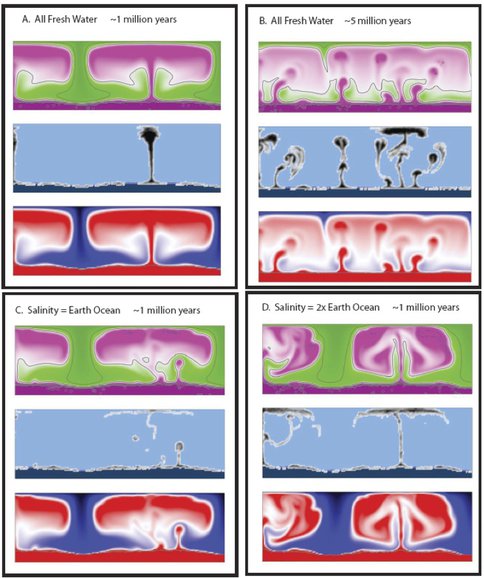2010 Annual Science Report
 Arizona State University
Reporting | SEP 2009 – AUG 2010
Arizona State University
Reporting | SEP 2009 – AUG 2010
Habitability of Water-Rich Environments, Task 2: Model the Dynamics of Icy Mantles
Project Summary
Europa, one of Jupiter’s moons, is one of the few places in our solar system hypothesized
to be habitable. Beneath a frozen, icy surface lies a liquid water ocean that could contain the chemical constituents required by life. Future missions to Europa will study its surface in detail in an effort to extrapolate the conditions below. So it is important to understand how mass can be transported from the deep ocean, through the ice, and to the surface of the moon. To understand this process, we are performing numerical fluid-dynamical calculations of 2-phase, thermochemical convection to investigate how chemistry from the deep ocean is transported to Europa’s surface. Furthermore, we are investigating how this material transport is expected to deform Europa’s surface, such that future missions will be able to infer deep, convective processes of the moon’s interior from surface observations.
Project Progress
We have performed numerical convection calculations to investigate mass transport within Europa’s icy shell. Firstly, we developed a Lagrangian tracer method within our numerical models to calculate the pressure- and temperature-dependent phase change between liquid water and solid ice. We performed 2-phase calculations in which an ice layer, of self-consistent thickness, convects while floating atop a liquid water ocean. We investigated the solidification of ocean water into the convecting ice shell to determine whether mass transport of oceanic chemistry into the ice layer and unto the surface is dynamically feasible. We found that significant mass transfer occurs across the ocean-ice boundary; therefore, it is feasible that ocean chemistry may be detected at the surface of the ice layer. Next, we investigated more-appropriate cases in which salinity differences within the ice drive a form of thermochemical convection. We found that the incorporation of variable salinity completely changes the style of convection occurring within the ice shell, in which fast, small-scale diapirs rapidly ascend through the ice layer and erode the high viscosity, near-surface portion of the ice shell. We have presented our results at two international conferences, and we are currently adding more-realistic dynamics/parameters into our models in preparation for publishing our results.
The top image is the logarithm of viscosity. Each contour represents a half order of magnitude change in viscosity, with greener colors representing higher viscosity regions and more-maroon colors representing lower viscosity. The middle image displays composition. Dark blue represents the low-viscosity proxy for liquid water, light blue represents ice originating from the start of the calculation, and dark gray color represents newly-created ice that is incorporated into the ice shell though freezing of oceanic water. The lower image displays temperature with colder temperatures represented by bluer color and hotter temperatures represented by redder color. A thin, gray contour marks the phase boundary. (A) Snapshot (at ~ 1 Myr) of case in which newly-formed ice has the same density of pre-existing ice. (B) Same as A, except at ~ 5 million years. (C) Snapshot (at ~ 1 Myr) of case in which newly-formed ice is about 3% less dense that pre-existing ice. (D) Snapshot (at ~ 1 Myr) of case in which newly-formed ice is about 6% less dense that pre-existing ice.
Publications
- Bunte, M.K., McNamara, A.K. & Greeley, R. (2010). Investigating ice shell convection with a lower boundary defined by changes in phase and composition: implications for Europa, #2523. Lunar and Planetary Science Conference. The Woodlands, TX.
-
PROJECT INVESTIGATORS:
-
PROJECT MEMBERS:
Mikhail Zolotov
Co-Investigator
Ronald Greeley
Collaborator
Melissa Bunte
Graduate Student
-
RELATED OBJECTIVES:
Objective 1.1
Formation and evolution of habitable planets.
Objective 2.2
Outer Solar System exploration

